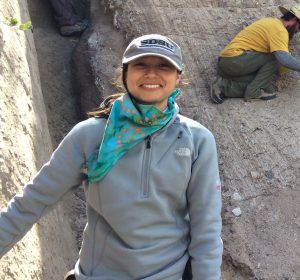Detrital Thermochronology: Record of the Local-to-Extraregional Provenance Shift
Recorded by the Northern Peninsular Ranges Forearc

Mia Flores
BS Candidate
Advisor: Dr. Dave Kimbrough
May 4th, 2017 – CSL 422, 11:45 am
watch Mia’s defense
Abstract
Previously measured detrital zircon U-Pb age distributions have revealed that Late Cretaceous to Eocene forearc strata in the Santa Ana mountains region experienced a dramatic shift in sedimentary provenance from a 125-90 Ma northern Peninsular Ranges batholith (PRB) source region along the continental margin to a cratonal source area intruded by Late Cretaceous (85-75 Ma) plutons within the continental interior (western Sonora). To improve our understanding of the timing and magnitude of denudation prior to, and during this local to extraregional provenance
shift, we have measured new detrital K-feldspar 40Ar/39Ar total fusion and zircon UPb age distributions from forearc sandstones. Our combined crystallization age and thermal history results confirm two pulses of rapid denudation of the PRB. These include a syn-batholith phase (Cenomanian) and a post-batholithic (Maastrichtian to Paleocene) phase attributed to shallow subduction. The new data require that significant (5-10 km) syn-batholithic erosional denudation of the northern PRB had already occurred by ca. 95 Ma and that post-emplacement denudation of the PRB
accelerated again during the Maastrichtian with the eastern PRB providing the bulk of the detritus. Our new results demonstrate that deposition of the Paleocene Silverado Fm. occurred during a transitional period. Sand reaching the forearc during the Paleocene was derived from both the heavily denuded eastern PRB with additional input supplied either from Late Cretaceous plutons of northwestern Sonoran region and/or similar plutons emplaced in thrust sheets atop PRB basement within the Santa Rosa Mountains. In contrast, the Eocene Santiago Fm. was nearly entirely derived from extraregional sources that supplied abundant late Cretaceous (75-85 Ma) and Proterozoic (1.4 & 1.7 Ga) detritus with virtually no PRB-derived sediment detected.

